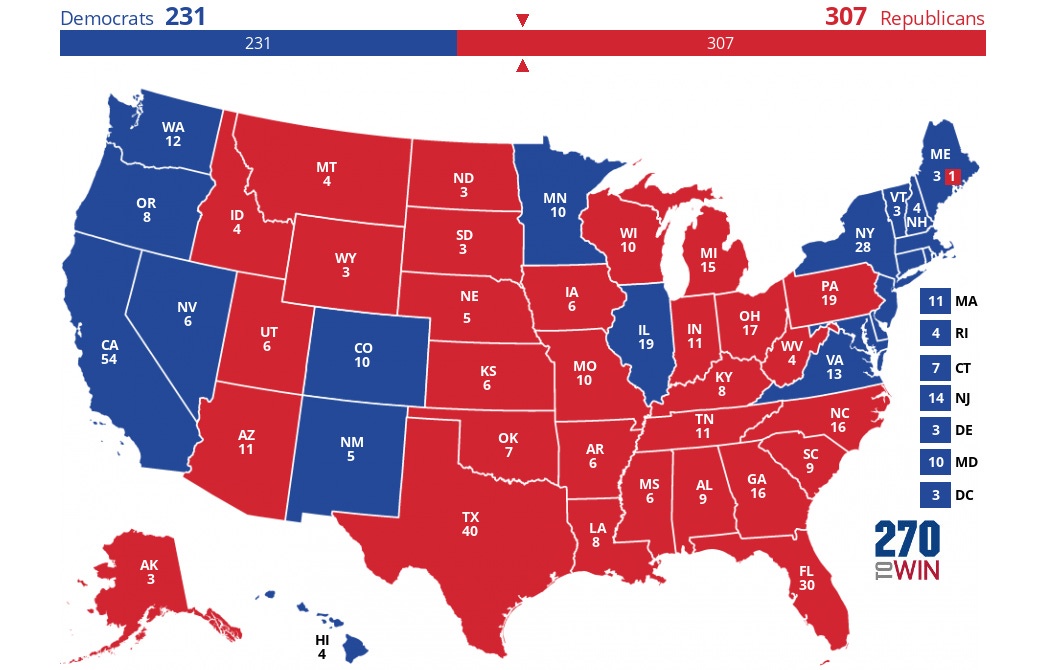What to Watch for on Election Night—and Beyond
The states that matter to the Electoral College count—and the chaos that may follow.

It would be so much simpler in so many ways if we chose our presidents by popular vote. There would be no elections decided by 500 bitterly contested votes in Florida after a Republican majority on the U.S. Supreme Court truncated the count. There would be none determined by a handful of demographically unrepresentative states which, all too often, reflect a bewildering mix of idiosyncratic election laws, parochial issues, and race-based voter suppression.
We wouldn’t worry about a squeaker decided by which party controls more congressional delegations. We wouldn’t wonder if the election of 2020 will be resolved by a Supreme Court so recently graced by a Republican justice rushed through the Republican Senate, and already tilted by the GOP’s stonewalling of a qualified Democratic nominee in 2016. We wouldn’t fret over “faithless electors.”
Nor do these vagaries reflect some higher principle designed for a country of 330 million diverse souls stretched across a vast continent and 50 states. Rather, they reflect a haphazard compromise cobbled together 233 years ago, to satisfy the less than 4 million white citizens of 13 prickly states strung along what is now America’s East Coast—including those determined to preserve the fruits of human slavery.
Hence this essay—my effort to guide readers through our arcane electoral map on an election night further complicated by the fallout from a very modern and deadly pandemic.
1. Reading the Electoral Map
The basic math of the Electoral College is easy. There are 538 electoral votes; to win the presidency a candidate must garner a bare majority—270. What can become difficult is charting the various combinations among a half-dozen or so closely contested states which could yield the next president—hopefully without the dubious assistance of state legislatures, Congress, or the courts.
The best analytic baseline is to start with the candidate favored in the polls, Joe Biden, and the number of electoral votes won by his unsuccessful Democratic predecessor in 2016, Hillary Clinton: 232 electoral votes—38 short.

Click the map to create your own at 270toWin.com
The Cook Political Report rates 14 states representing 188 electoral votes as “solid Democrat”; and another three with 24 electoral votes—Colorado, Maine and Virginia—as “likely Democrat.” Among those denominated “lean Democrat” are three more containing 20 electoral votes—Minnesota, Nevada, New Hampshire—where Biden holds solid leads in the polls.
Unsurprisingly, these states reprise the 232 electoral votes Clinton won in 2016. In a year when Biden is running stronger, and Donald Trump has historically low approval ratings, it seems reasonable to use this as the Democrat’s electoral foundation.
Conversely—and despite some promising polls—in this age of hyperpolarization and GOP voter suppression it seems imprudent to assume that Biden can take traditionally red Georgia and Texas, or red-trending Iowa and Ohio. That said, if Biden wins any one of these “stretch states”—most plausibly Georgia—he can start humming “Hail to the Chief” and you can stop holding your breath.
In the meanwhile, however, one should focus on the universally acknowledged battleground states: Arizona, Florida, Michigan, North Carolina, Pennsylvania, and Wisconsin—and, in a pinch, two electoral votes in states which award them by congressional district: Maine and Nebraska.
To aid our analysis, let’s divide these jurisdictions into three categories:
The Rust Belt: Michigan (16), Pennsylvania (20), and Wisconsin (10).
Throughout the fall, Biden has held solid leads in Michigan and Wisconsin, and smaller but generally consistent margins in Pennsylvania. These are the states where, in 2016, non-college-educated whites gave Trump razor’s edge victories that carried the Electoral College.
Should Biden win all three, he will have 278 electoral votes—and the presidency. The likelihood that Biden will carry Michigan and Wisconsin—where rates of COVID-19 are spiking—makes it imperative for Trump to capture Pennsylvania.
The Sun Belt: Arizona (11), Florida (29), and North Carolina (15).
In 2016, Trump won all three. In 2020, Biden has held narrow but persistent polling leads in Arizona—which, since 2016, has been trending blue. But Biden’s margins in Florida and North Carolina have been vanishingly slight.
In any calculus, Trump must claim Florida—should Biden win there, he needs but one more battleground state. Biden can hope to carry Arizona, his clearest shot in the Sun Belt, as a hedge against losing Florida and Pennsylvania.
Bottom line: In all probability, Trump must sweep the Sun Belt—and add Pennsylvania.
The Puzzle Pieces: Maine 2nd (1) and Nebraska 2nd (1).
While Trump won these congressional districts in 2016, current polls show him trailing in both—and by significant margins in Nebraska 2nd. Either could become the last vote which gives the winner 270.
Their character is very different: Maine 2nd is blue-collar and rural; Nebraska 2nd more upscale and suburban, reflecting a demographic which is abandoning Trump. For Trump to lose either would signal larger problems.
Biden’s Paths to Victory
To enumerate them illustrates why Biden is favored to garner the presumptive 38 electoral votes he needs to add to the blue total from 2016:
Winning Florida and any other state: the smallest, Wisconsin, would give him 39.
Sweeping the Rust Belt—Pennsylvania, Michigan, and Wisconsin—would secure 46.
Taking Michigan, Arizona, and Wisconsin yields 37; adding either congressional district gives Biden 38.
Carrying Arizona, North Carolina, and Michigan would get Biden to 42—even without the two largest prizes, Florida and Pennsylvania.
One can go on like this in descending order of likelihood. For example, North Carolina Arizona, Wisconsin, and the two congressional districts also total 38.
You get the point. Because Biden should net Michigan and Wisconsin and their 26 votes, he needs only 12 more.
Trump’s Paths to Victory
As noted above, absent enormous surprises in the Rust Belt Trump needs to keep Florida if he is to reach 270. An assortment of early vote demographics and late-breaking polls suggest that Trump has reason to hope that Florida will go his way, albeit narrowly.
But winning Florida is just the beginning.
For example, if, in addition to Florida, Trump wins Pennsylvania and North Carolina but loses Wisconsin and Michigan, he would still have to win another state—presumably Arizona—to reach 270. It’s like a kid’s tower constructed from blocks: remove one, and the edifice tumbles.
One keeps returning to Trump’s seeming sine qua non: the three Sun Belt states, plus Pennsylvania. Otherwise—absent flipping a Clinton state, like Minnesota—he’s toast.
Note that it’s theoretically possible for the Electoral College to yield a 269-269 tie, which throws the election into the House of Representatives—and another archaic maze. For example, if the only states to change from the 2016 map were Arizona, Michigan, and Wisconsin—if just those three states flipped to Biden, with no other change—the result would be a tie.
Fortunately, that scenario, and several of the combinations that would yield a tie, would likely require a further improbability: Trump again winning both congressional districts. For those resolved to ponder the worst, I recommend Elaine Kamarck’s enlightening article for Brookings.
2. Reading the Initial Returns
The evening of election day 2020 is unlikely to yield a clear winner. Slim margins, recounts, and court challenges are often the norm in battleground states. And because of the pandemic, an unprecedented volume of mail-in ballots may delay a final count while generating numerous legal controversies.
Nonetheless, those first hours should offer clues to the ultimate outcome. Nate Silver currently projects a turnout of 17 million votes more than in 2016—in general, the higher the turnout, the better for Democrats.
But here lurks a complication unique to 2020. The large volume of mail-in ballots is expected to favor Democratic voters, concerned about the pandemic, while Republicans are expected to dominate in-person voting on election day. In Pennsylvania, for example, a larger-than-expected turnout on November 3 may augur a good day for Trump—especially because the GOP holds an appreciable edge in registering first-time voters.
But Pennsylvania also exemplifies why early returns may prove especially deceptive in 2020—it counts more in-person ballots first. Among other battleground states practices vary as to whether the early returns reflect the quick tabulation of in-person ballots or the processing of mail-in ballots received before election day.
Finally, some states count mail-in ballots postmarked on election day but received thereafter; others do not. That may prove critical.
All this also bears on how swiftly to expect final returns from particular states. It helps to know the practices in each, and when their election officials expect a completed count. Those states which have a reasonably final count on November 3, or within hours thereafter, may preview the ultimate winner.
Here’s what to anticipate from the six battleground states:
Arizona. The state begins counting mail-in ballots prior to election day. Election officials expect a reasonably final count on Tuesday evening.
Florida. Florida begins processing mail-in ballots early—and disqualifies those received after election day. Despite its tangled history, we can anticipate a fairly complete—though perhaps inconclusive—count within hours after the polls close. As in Arizona, early returns may be skewed toward mail-in ballots.
Michigan. Although a new law enacted last month allows some Michigan jurisdictions to begin processing ballots on the eve of the election (today), no ballots are actually counted prior to election day, and officials don’t predict complete results until November 6.
North Carolina. The state processes mail-in ballots early, and counts ballots postmarked by election day and received by November 12. The early returns will favor mail-in ballots; the later in-person ballots. But officials estimate that roughly 98 percent of ballots will be reported on election night.
Pennsylvania. This year’s primary was a mess—it took six days to count mail-in ballots—and the general election should be even worse. Because Pennsylvania processes no ballots early, official hopes that “the overwhelming majority” will be counted by November 6 may prove aspirational. Amid a nationwide delay in delivering mail-in ballots to voters, the problem seems particularly acute in Philadelphia—auguring late-arrived ballots. That most mail-in ballots will be tallied last will generate further controversy.
Wisconsin. Tabulation starts when the polls close. However, officials expect the count to be substantially complete by November 3 or 4.
As for the two congressional districts, results should come quickly. Neither Maine nor Nebraska count ballots received after election day; in both states, early processing of ballots is already underway.
If reality conforms to expectations, on the evening of November 3 we should have near-complete counts from these districts and the three Sun Belt states. Should the winner in those jurisdictions be clear, we can reach some tentative conclusions.
As noted, even if Trump sweeps the Sun Belt, he still must take Pennsylvania—assuming that, as expected, Biden ultimately carries Wisconsin and Michigan.
Watch Arizona closely—among the states reporting early, it could become the key. Should Biden win only Arizona and one congressional district, he’s our presumptive president—again, pending victories in Wisconsin and Michigan. In that scenario, Pennsylvania becomes superfluous.
But if Biden loses the Sun Belt, he must sweep the Rust Belt. Wisconsin is likely to report first—shedding light on demographically similar Michigan. Should the election turn on Michigan or Pennsylvania—or both—we will likely have to wait until November 6, at the earliest, for results we can believe in. And Pennsylvania may remain unresolved.
At that point the real problem is Trump.
3. The Nightmare Scenario: Post-Election-Day Chaos
Americans are accustomed to believing that our presidential elections, with rare exceptions, are settled on election day. But that perception rests on projections and unofficial results—not final tabulations.
Nonetheless, suppose that the returns in battleground states as of November 3, however incomplete, show Trump with a tentative lead in the Electoral College. Beyond doubt he will declare victory—and assert that any further counting, particularly of mail-in ballots, reflects massive voter fraud.
The foundation for this charge—Trump’s mendacious assertion that voting by mail during a pandemic licenses Democrats to hijack the election—has caused a partisan split in how Americans vote. With many more Democrats than Republicans casting mail-in ballots, vote counts may seesaw depending on which type of ballots are tabulated first.
If later counts reflect a “blue wave” of mail-in ballots for Biden, Trump will likely use this to buttress his claims of fraud. In any state where the results hang in the balance, he will attempt to stop the tabulation of such ballots—including those received after election day.
Given Trump’s stated resolve to recruit Republican officials, legislators, and judges—including the U.S. Supreme Court—to skew the election, America faces the prospect of naked chicanery amidst toxic uncertainty. The inevitable consequence would be grave damage to our social, political, and constitutional fabric.
I won’t reprise the disparate disasters others have written about so copiously—such as Republican state legislatures picking a second slate of electors to compete with those representing the apparent winner: Joe Biden. But recent Supreme Court orders suggest that a conservative majority of justices could intervene to give Trump a second term he lost at the ballot box.
Take last Monday’s ruling barring Wisconsin from counting timely mail-in ballots received after election day. Particularly troubling was the reasoning proffered by Justice Kavanaugh: that election-day cutoffs were designed “to avoid the chaos and suspicions of impropriety that can ensue if thousands of absentee ballots flow in after election day and potentially flip the results of an election.” That precisely mirrors Trump’s bogus rationale—including the groundless insinuation of “impropriety.” (To his presumptive embarrassment, Justice Kavanaugh subsequently had to issue a correction to part of his ruling.)
Since then Amy Coney Barrett has become the Court’s ninth justice. Quite explicitly, Trump ramrodded her confirmation so that she could rule on litigation concerning the election, and he continues to forecast that the Court will help him win the election. This possibility has impelled Democrats to request that she recuse herself from such cases. If she does not, Barrett could prove decisive in litigation over mail-in ballots in Pennsylvania.
Given a postal service overwhelmed by the volume of mail-in ballots occasioned by the pandemic, the Pennsylvania Supreme Court ruled that ballots received by November 6 could be counted if postmarked on election day. That decision barely survived a Republican challenge which spawned a 4-4 deadlock in the U.S. Supreme Court. Unsurprisingly, the GOP asked the Court to intervene yet again. Last Wednesday it declined to do so.
But the Court’s shadow still looms over Pennsylvania. In ruling, Justices Thomas, Gorsuch, and Alito expressed interest in revisiting the question after November 3, based on a startling repudiation of federalism: that the Court can overrule state court interpretations of state law. Accordingly, state election officials decreed that ballots arriving after 8 p.m. on November 3 must be segregated—enabling the Court to disallow them in a subsequent decision.
Critically, Justice Barrett did not participate because she joined the Court too late, but did not recuse herself. Thus she could become the crucial fifth vote Republicans need to void late-received ballots—potentially deciding the election.
As elections expert Rick Hasen told Thomas B. Edsall: “If it turns out to be really close and it comes down to Pennsylvania, God help the United States of America. . . . It will be trench warfare over ballots and a president seeking to cast major doubt over the legitimacy of the election even without evidence of major problems. It would be much worse than Bush v. Gore because of Trump’s rhetoric, because we are more polarized and many see this election in existential terms, and because internal and external forces can use social media to spread disinformation and fan the flames of hate.”
That may define the stakes on election day—and beyond. If there is an honest count in battleground states untainted by partisan subversion, Joe Biden will likely become our 46th president. If not, the election of 2020 may determine not just the presidency, but how strong—or even real—American democracy truly is.






